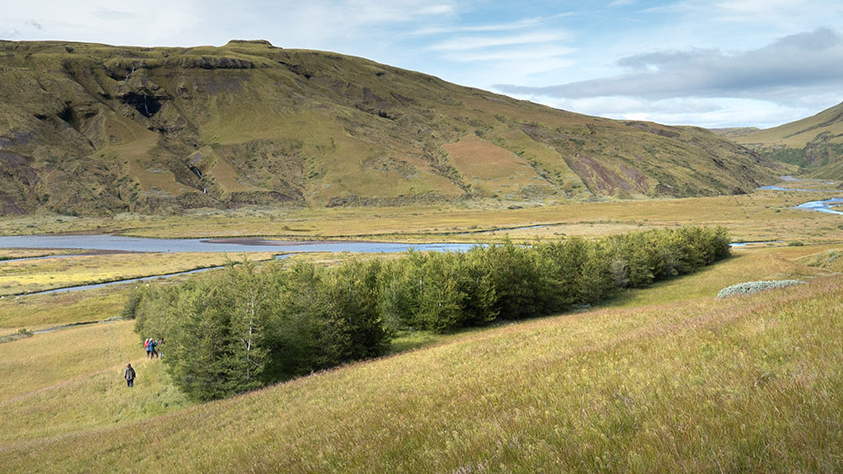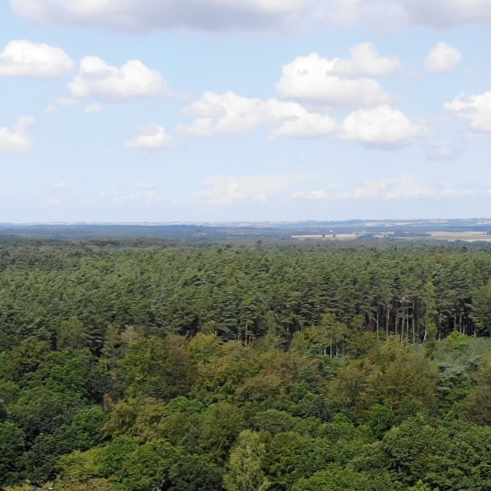
Overview of the Most Important Species in Each Country
Choice of species for forest production varies across the Nordic region based on which tree species are naturally occurring and which thrive and produce under different climatic conditions. This, and the fact that available statistics vary among the countries, makes comparisons challenging across countries. Therefore, not all statistics are presented for all countries and species.
Seedlings in Sweden, Finland, and Norway
As an overview of the most important species in the production chain for the different countries the amount of seedlings delivered to the forestry in 2021 is shown below (Figure 1-4). In Finland, Sweden and Norway the two conifers Norway spruce (Picea abies) and Scots pine (Pinus sylvestris) make up most of the plant production for forestry. Norway spruce makes the biggest share for commercial production of these two due to the large extent of natural regeneration and direct seeding of pine. Sweden has the largest forest area while Norway has the smallest among these three countries.
Top photo: Michael Angeloff/NIBIO.
Sweden
452.000.000 seedlings in total
Figure 1
Figure 1-3 shows rounded percentage of seedlings delivered to Swedish, Finnish and Norwegian forestry in different species categories in 2021. The total amount is rounded to thousand seedlings.
Finland
152.088.000 seedlings in total
Figure 2
In the category "Other" the percentage is 0,2 percent.
Norway
45.502.000 seedlings in total
Figure 3
In the category "Other" the percentage is 0,5 percent.

Flowering spruce (Picea abies). Photo: Arne Steffenrem Skogfröverket/NIBIO.
Seedlings in Iceland
The main species used for afforestation in Iceland is the native birch (Betula pubescens). Silver birch (Betula pendula) may be an alternative in lowland areas with increasing temperatures. Seeds are collected in the wild or from planted trees. Other important species in Iceland include Larix sibirica, Larix decidua and the hybrid Larix sibirica x Larix decidua, Populus trichocarpa, Pinus contorta, Picea sitchensis, Picea glauca and Abies lasiocarpa (Christmas trees).
Iceland
5.319.000 seedlings in total
Figure 4
Percentage of seedlings delivered to Icelandic forestry in different species categories in 2021.
Afforestation in Iceland
The first official National Forest Plan for Iceland was published in August 2022 by the Ministry of Food, Agriculture and Fisheries. After years of cutbacks due to the economic recession from 2008, the afforestation budget in Iceland has started to increase again, especially due to the efforts to reach the goals of the Paris Agreement on Climate change and the system of carbon credits causing an increased interest from the private sector and foreign companies to invest in afforestation in Iceland. In the next ten years about 15.000 hectares will be planted and 350.000 hectares of land will be restored by birch forest with natural methods. In 2022 Iceland reached 2 percent cover of forest and woodland. Another milestone this year was that the tallest tree in Iceland, a sitka spruce planted in 1949 at Kirkjubæjarklaustur, reached 30 meters height.

Seedlings in Denmark
Seedling statistics for Denmark is not available. As an overview of the most important species in the Danish forestry, the proportions of the total forest area covered by each species are presented in the pie chart below. It is important to note that the conifers are planted and introduced species, whereas for instance beech (Fagus sylvatica) and sycamore (Acer pseudoplatanus) often are regenerated naturally. Furthermore, the yearly use of seedlings is higher for short-rotation Christmas trees (e.g. Abies species) than for typical long-rotation species such as oak (Quercus spp).
Denmark
640.835 hectares in total
Figure 5
Area of the 10 most common tree species in Denmark. References: Nord-Larsen, T., Johannsen, V. K., Riis-Nielsen, T., Thomsen, I. M., Bentsen, N. S., & Jørgensen, B. B. (2023). Skovstatistik 2021.
Forest Areas Are Set Aside for the Benefit of Nature
With the goal of a total of 75,000 hectares of untouched forest, approximately 12 percent of the forest area in Denmark would be left untouched. The majority of the forests becoming untouched are state-owned.
In 2022 an important milestone in the work of setting aside areas was reached as 28.000 hectares of state-owned forest was selected for this purpose. With this latest setting a side of areas the goal of a total of 75.000 ha of untouched forest is almost reached.
A common thing for the untouched forests – regardless of where they are located – is the stop of commercial forestry, and that dead trees and fallen trunks are left in the forests for the benefit of biodiversity.
In the implementation of the untouched forests there will be a restoration period, where different processes are initiated through a number of restoration activities. These restoration activities include for instance felling of mainly non-native conifer species. Also, the hydrology of the areas is restored by closing of ditches and drains, so small lakes, bogs and mires again become an integrated part of the forests. Veteranization of trees will assure higher levels of standing and laying dead wood in the untouched forests.
Cutting of hardwood tree species will gradually be phased out, in order to ensure the accessibility of certified wood during a transitional period to the Danish sawmills.
